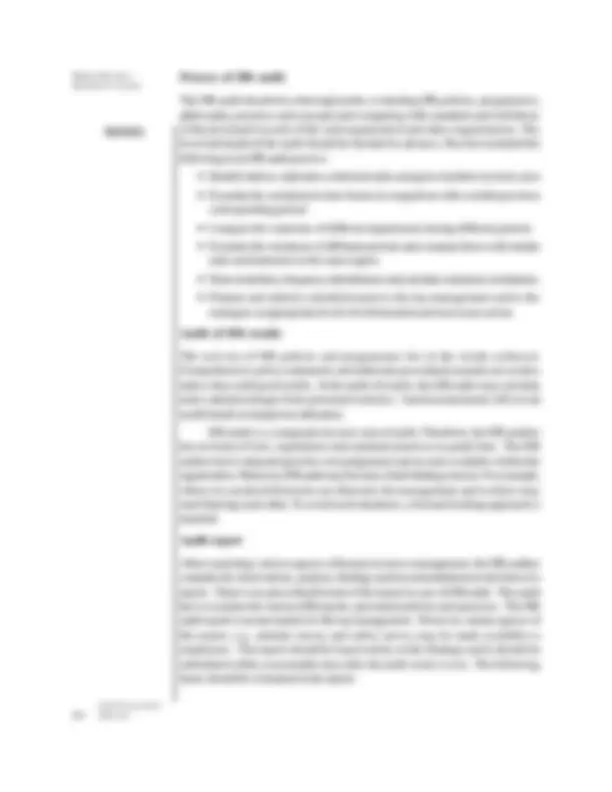



Study with the several resources on Docsity

Earn points by helping other students or get them with a premium plan


Prepare for your exams
Study with the several resources on Docsity

Earn points to download
Earn points by helping other students or get them with a premium plan
Community
Ask the community for help and clear up your study doubts
Discover the best universities in your country according to Docsity users
Free resources
Download our free guides on studying techniques, anxiety management strategies, and thesis advice from Docsity tutors
Human Resource Management (HRM) is a strategic and comprehensive approach to managing people within an organisation. It involves recruiting, hiring, training, evaluating, and rewarding employees to maximise their performance and align with the organisation’s goals. HRM also ensures compliance with labour laws, fosters a positive workplace culture, and supports employee development and well-being. By managing workforce planning, performance, compensation, and employee relations, HRM plays a vital role in organisational success. In today’s dynamic business environment, HRM is increasingly data-driven and aligned with long-term strategic planning, making it an essential function in both large corporations and small enterprises.
Typology: Lecture notes
1 / 2

This page cannot be seen from the preview
Don't miss anything!


Human Resource Information System
Self-Instructional Material 173
valuation. HRA may result in division among the ranks of employees. A group of employees may be valued lower than their real worth due to manipulations by the management. Such manipulative practices will be protested against by the unions.
14.3.3 Personnel Audit
An audit is a review and verification of completed transactions to see whether they represent a true state of affairs of the business or not. Though there is no legal obligation to audit personnel policies and practices, informed employers voluntarily use it as a tool for evaluation and control of personnel function.
Qualitative and quantitative indicators for HR audit
Table 14.1 outlines the most commonly used qualitative and quantitative indicators of effectiveness classified by major functions. It should be remembered that these indicators are not fool proof and may not be applicable in all cases.
Table 14.1 Qualitative and Quantitative Indicators for HR Audit
Major Functions Qualitative Indicators Quantitative Indicators
Turnover rates, selection rates, retrenchment, dismissal and lay- offs, recruitment time-lag and recruitment ratios
Time taken in training, apprentice ratios, scrap losses, productivity increases
Wage and salary differentials, benefit range and costs, number of employees earning bonus in excess of standard rate
Measured morale, measured communication, absenteeism and turnover rates, number of grievances, suggestion ratios, accident rates
Work stoppages, grievances and their settlement, arbitrations, costs
Source: Tripathi, P.C. 1999. ‘Personnel Management and Industrial Relations’. New Delhi: Sultan Chand and Sons, pp. 126–127.
Human Resource Information System
Self-Instructional 174 Material
Process of HR audit
The HR audit should do a thorough probe, evaluating HR policies, programmes, philosophy, practices and concepts and comparing with standards and with those of the personnel records of the said organization and other organizations. The level and depth of the audit should be decided in advance. Rao has included the following in an HR audit process: Identify indices, indicators, statistical ratios and gross numbers in some cases Examine the variations in time-frame in comparison with a similar previous corresponding period Compare the variations of different departments during different periods Examine the variations of different periods and compare them with similar units and industries in the same region. Draw trend lines, frequency distributions and calculate statistical correlations. Prepare and submit a detailed report to the top management and to the managers at appropriate levels for information and necessary action. Audit of HR results
The real test of HR policies and programmes lies in the results achieved. Comprehensive policy statements and elaborate procedural manuals are useless unless they yield good results. In the audit of results, the HR audit may calculate ratios and percentages from personnel statistics. Such measurement will reveal useful trends in manpower utilisation. HR audit is a comparatively new area of audit. Therefore, the HR auditor has no body of laws, regulations and standard practices to guide him. The HR auditor has to depend upon his own judgement and records available within the organization. Moreover, HR audit may become a fault-finding exercise. For example, wherever certain deficiencies are detected, the management and workers may start blaming each other. To avoid such situations, a forward looking approach is required.
Audit report
After examining various aspects of human resource management, the HR auditor compiles his observations, analysis, findings and recommendations in the form of a report. There is no prescribed format of the report in case of HR audit. The audit has to examine the various HR reports, personnel policies and practices. The HR audit report is meant mainly for the top management. However, certain aspects of the report, e.g., attitude survey and safety survey may be made available to employees. The report should be based solely on the findings and it should be submitted within a reasonable time after the audit work is over. The following items should be contained in the report: